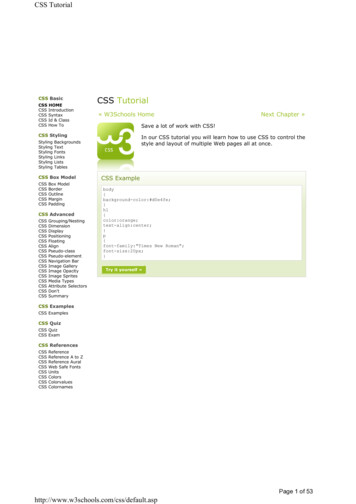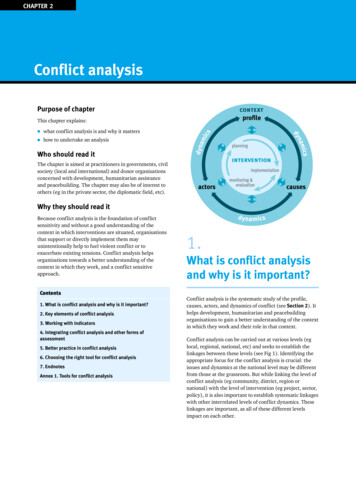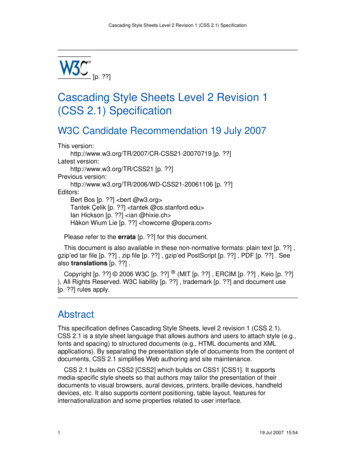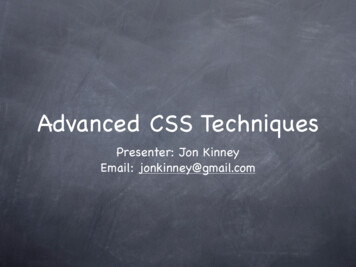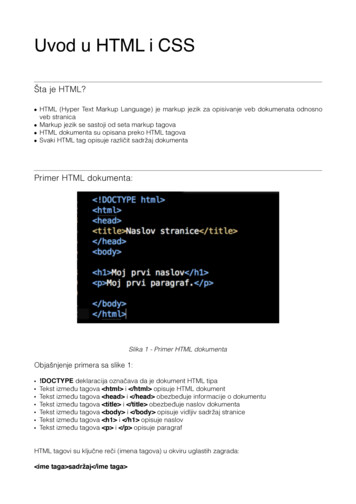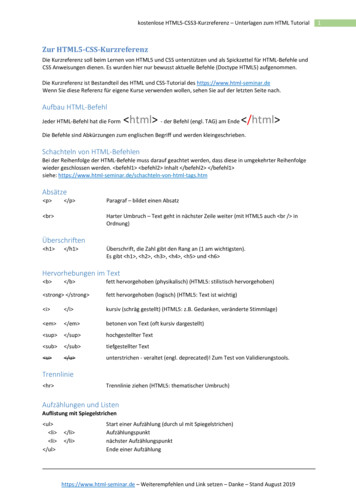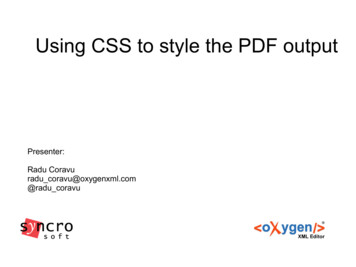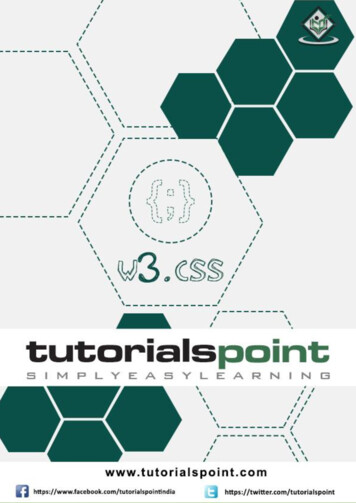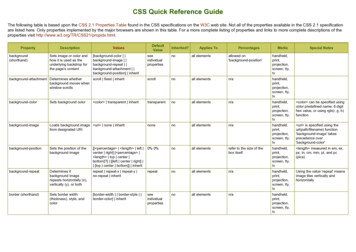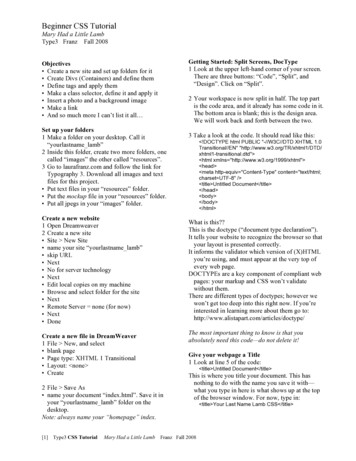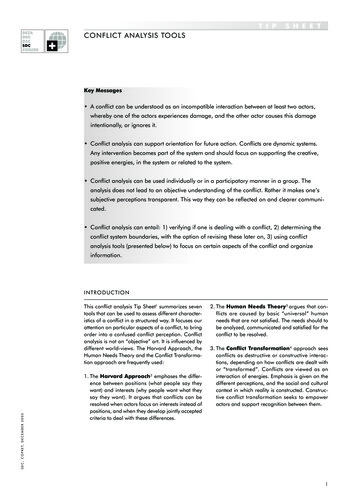
Transcription
T I PS H E E TCONFLICT ANALYSIS TOOLSKey Messages A conflict can be understood as an incompatible interaction between at least two actors,whereby one of the actors experiences damage, and the other actor causes this damageintentionally, or ignores it. Conflict analysis can support orientation for future action. Conflicts are dynamic systems.Any intervention becomes part of the system and should focus on supporting the creative,positive energies, in the system or related to the system. Conflict analysis can be used individually or in a participatory manner in a group. Theanalysis does not lead to an objective understanding of the conflict. Rather it makes one’ssubjective perceptions transparent. This way they can be reflected on and clearer communicated. Conflict analysis can entail: 1) verifying if one is dealing with a conflict, 2) determining theconflict system boundaries, with the option of revising these later on, 3) using conflictanalysis tools (presented below) to focus on certain aspects of the conflict and organizeinformation.INTRODUCTIONS D C , C O P R E T, D E C E M B E R 2 0 0 5This conflict analysis Tip Sheet1 summarizes seventools that can be used to assess different characteristics of a conflict in a structured way. It focuses ourattention on particular aspects of a conflict, to bringorder into a confused conflict perception. Conflictanalysis is not an “objective” art. It is influenced bydifferent world-views. The Harvard Approach, theHuman Needs Theory and the Conflict Transformation approach are frequently used:1. The Harvard Approach 2 emphases the difference between positions (what people say theywant) and interests (why people want what theysay they want). It argues that conflicts can beresolved when actors focus on interests instead ofpositions, and when they develop jointly acceptedcriteria to deal with these differences.2. The Human Needs Theory3 argues that conflicts are caused by basic “universal” humanneeds that are not satisfied. The needs should tobe analyzed, communicated and satisfied for theconflict to be resolved.3. The Conflict Transformation4 approach seesconflicts as destructive or constructive interactions, depending on how conflicts are dealt withor “transformed”. Conflicts are viewed as aninteraction of energies. Emphasis is given on thedifferent perceptions, and the social and culturalcontext in which reality is constructed. Constructive conflict transformation seeks to empoweractors and support recognition between them.1
Once we have decided that the situation we aredealing with is a conflict, we need to decide on thesystem boundaries. What actors and factors do wewant to focus on, which ones shall we leave out forthe moment? One can focus on various “systems”.Every conflict is a sub-system in a larger system – itscontext (or super-system). A conflict in one sub-system may only be a symptom of a conflict located inthe “context” of a larger system. Domestic violence,for example, may be part of a conflict between twoland-use systems, which is embedded in an ethnopolitical conflict in one country, which in its turn isaffected by different international policies dealingwith economic trade. A conflict is often enacted ata system’s weakest point, not necessarily where it iscaused. Thus whenever analyzing conflicts, we mustconsider the system boundaries we have set, andreflect on how they relate to the environment theconflict is embedded in. Depending on where weset the boundaries, the conflict will present itself differently. The boundaries have to be revised periodically, to make sure we are working where we havethe best leverage. After setting the conflict systemboundaries, we can use one or more of the following tools to deepen our insight onto various aspectsof the conflict.HO W TO U S E T H E C O N F L I C T A N A LY S I S TO OLSAll the conflict analysis tools are structured in thesame way: 1) description of the tool, 2) aim of thetool, and 3) step by step instructions on how touse the tool. The tools can be categorized accord-ing to their focus on dynamics, actors, causation,structures, issues and options/strategies. The Conflict Wheel summarizes all the tools and helps youdecide which tool to use for which aspect.SUM M A RY O F C O N F L I C T A N A LY S I S TO O L S1. Conflict Wheel: Introduces six important dimensions of conflict analysis (dynamics, actors, causation, structures, issues and options/strategies).It organizes the other conflict analysis tools andis a “meta” tool.2. Conflict Tree: The conflict tree deals with the difference between structural and dynamic factors, visualizing how conflict issues link these twoaspects.3. Conflict Mapping: The conflict mapping focuseson actors and their interrelationships. It is a goodtool to start analyzing a conflict. Power asymmetry can be represented by the relative size of theactors circles. Animosity and alliances are symbolized with lines.4. Glasl’s Escalation Model: The model aims to fitour conflict intervention strategy to the conflictparties’ escalation level. The message is that itmay be pointless to talk to a suicide bomber, orshoot people who are shouting at each other.25. INMEDIO’s Conflict Perspective Analysis (CPA):The Conflict Perspective Analysis (CPA) focuseson the different perspectives of the various parties. By putting them side by side, one can seewhere there are differences and things in common. CPA follows the phases of a mediation. Itis a good preparation for a mediation, can alsobe used to coach one conflict party. CPA does notlook explicitly at structures or context.6. Needs-Fears Mapping: Similar to the CPA, thismethod focuses on actors and their issues, interests, needs, fears, means and options. It allowsfor a clear comparison of actors similarities anddifferences in the form of a table.7. Multi-Causal Role Model: This model focuses oncausation, on the different quality of reasons,triggers, channels, catalysts, and targets. Content and actors, dynamics and structures are alsoconsidered.
T I PS H E E TCONFLICT ANALYSIS TOOLSTO O L 1 : T H E C O N F L I CT WHEELDescription: The conflict wheel is a “meta” conflictanalysis tool, introducing the others tools. Each ofthe six sections of the wheel can be further analysed using tools presented below (or referencesto other Tip Sheets). The Wheel gives a first overview of a conflict, before analysing specific aspects.The Wheel symbolizes wholeness and movement,once the various aspects have been examined, theyneed to be brought together again, to get the conflict analysis “rolling”.Aim: To organize the other conflict analysistools To serve as an overview when firstapproaching a conflict.1. Actors/Relations: Actors or “parties” are people,organizations or countries involved in a conflict.If they are directly involved in the conflict they arecalled “conflict parties”, if they become involvedtransforming the conflict, they are called “thirdparties”. Stakeholders have an interest in the conflict or its outcome, but are not directly involved.Conflicts by definition refer to frictional relationships between parties.2. Issues are the topics of the conflict; what peoplediscuss or fight about.3. Dynamics refer to the escalation level of the conflict, the intensity of interaction, the “temperament” and the energy of a conflict that transformspeople.4. Context/Structures: The conflict context and structural factors are often outside the conflict systemone is looking at. Structural violence refers to violence that is not directly caused by people, but bythe economic and political systems in place, e.g.causing poverty.5. Causation: Conflicts are never mono-causal,but multi-causal and systemic factors interact.Instead of saying that everything is related to everything, it is helpful to differentiate between different “causes” or influence factors.6. Options/Strategies: This point examines ways todeal with the conflict, strategies that are used orcould be used, conflict party or third party effortsto de-escalate the conflict.CPANeeds-Fears MappingSee also “Gender andConflict” Tip SheetCPANeeds-Fears MappingGlasl’s Escalation ModelConflict TreeGlasl’s Escalation ModelMulti-Causal Role Model2. IssuesNeeds-Fears MappingCPAConflict Mapping1. Actors/Relations3. Dynamics6. Options /Strategies4. Context /Structures5. CausationS D C , C O P R E T, D E C E M B E R 2 0 0 5See also “Do No Harm”and “PCIA” Tip SheetSee also “Do No Harm”Tip SheetConflict TreeSee also “Do No Harm”Tip SheetMulti-Causal Role ModelStep by step instructions:1. Draw a wheel, list the various aspects in the sixsections of the wheel.2. Choose further conflict analysis tools for thoseaspects you want to examine in more depth.3
TOO L 2 : T H E C O N F L I C T T R E E 5Description: The conflict tree is a visualizing and sorting tool. The tree visualises the interaction betweenstructural, manifest and dynamic factors. The rootssymbolise structural “static” factors. The trunk represents the manifest issues, linking structural factorswith the dynamic factors. The leaves moving in thewind represent the dynamic factors.Dynamic Factors: Dynamic factors include the formof communication, escalation level, relationshipaspects etc. Working with dynamic factors involvesa short time horizon; reactions to interventionsare quick and at times unpredictable. Examplesare diplomatic interventions, or multi track conflict transformation dealing directly with the formof interaction between the conflict parties. Quickmoney is often more important than big moneywhen addressing dynamics m unicati on tiMiscommunicaiononRefugeeRefuef gee CampsefuRefugeeCampsLand AlienationManifest issues: Issues are what the conflict partieswant to talk about, the “topic” of the conflict.Structural Factors: Root causes are the basic “reason” of the conflict. They are difficult to influenceon a short time basis, if they are avoided, however,the conflict may pop up again later. This is the typical area for development cooperation, longer-terminvolvement and the prevention of structural violence (Human Needs Theory).Aim: To initiate reflections on the linksbetween root causes, issues anddynamic factors To differentiate the time horizons ofvarious conflict transformationapproaches4Coupsd’Etatd' EtatCoupsStatesWWeakeak StatesElite PoliticsElit e Politi csGrGroupoup HiHistoricsstoriesCulturalCulturalDi Discriminationscrim inati onStep by step instructions:1. Draw a picture of a tree, including its roots, trunkand branches – on a large sheet of paper or aflipchart.2. Each person gets several index cards, on whichthey write a word or two, or draw a symbol or picture, indicating important factors of the conflict asthey see it.3. Invite people to attach their cards to the tree: on the roots, if they see it as a root cause on the trunk, if they think it is a manifestissue, a “topic” of the conflict on the branches, if they see it as a dynamicfactor influencing the conflict4. Someone facilitates the discussion on where thefactors are placed on the tree. There is no absolute “right” or “wrong”. Placement of factors ispartly subjective, may be different in differentconflicts, and may change over time. Nevertheless, try as a group to create a common snap shotof the conflict as the group sees it.5. People can visualise their own conflict transformation efforts (e.g. as a bird or worm) and placethis on the tree in relation to the factors they arecurrently working on.6. Discuss the links between root causes and dynamics factors and how to address these.
T I PS H E E TCONFLICT ANALYSIS TOOLSTO O L 3 : C O N F L I C T M AP 6Description: Similar to a geographic map that simplifies terrain so that it can be summarized on onepage, a conflict map simplifies a conflict, and servesto visualise 1) the actors and their “power”, or theirinfluence on the conflict, 2) their relationship witheach other, and 3) the conflict theme or issues. Aconflict map represents a specific view point (of theperson or group mapping), of a specific conflict situation (it should not not be too complex!), at a specific moment in time, similar to a photograph.Aim: To clarify relationships between actors To visualize and reflect on the “power”of various actors To represent the conflict on one sheet ofpaper, to give a first conflict overviewSudan North South ConflictIssues: 1) Security, military arrangement, 2) Sharingpower,3) Sharing4) The capital, 5) The threeSudanNort h Souwealth,th C o nflictIssues:1) Security,arrangement,2) Sharing power, 3) Sharing Wealth, 4)areas:Bluenile,militaryNubaand AbyeyThe Capital, 5) The 3 areas: Blue nile, Nuba and AbyeyGo SStep by step instructions:1. Decide on the conflict you want to analyse. Setthe conflict system boundaries.2. Form groups of two or more people. One canmake a conflict map by oneself, but in a group isbetter. If there are people in the group that knownothing of the conflict, they can help by asking clarifying questions, by being a person theinvolved actor can talk to and test ideas on.3. Take a large sheet of paper and draw the actorsas circles on the paper, or on cards that can bepinned on a paper, the size of the circle representing an actors’ “power”. Do not forget to putyourself as an actor on the page as well, if you oryour organization is involved. List third parties assemi-circles.4. Draw lines (see symbols below) between the circles representing the relationship between theactors.5. In square boxes, or at the top of the map, list themain themes. For more details on each actor, usethe Needs-Fears mapping tool.6. Don’t forget to add title and date to the conflictmap, and if not confidential, also the name ororganization of the person mapping.IGA DFrie nd sof IGA D:US A ,Bel g .It al. G BU mmaSPLAND AUS AOc t 2003Possible symbols used in conflict mappingS D C , C O P R E T, D E C E M B E R 2 0 0 5Circle parties involved in the situation. The size of the circle symbolized the power of the conflict partyin relation to the conflict. The namecan be written in the circle.Straight line close relationshipArrow predominant direction ofinfluence or activityZig zag line discord, conflict. Lighting bolts can be added to indicatehot events.Crossed out line broken connectionDouble line Very good relationship, allianceHalf circles or quarter circle external parties, third partiesDotted line weak, informal orintermittent linksRectangular boxes issues, topics orthings other than people and organizations5
TOO L 4 : G L A S L’ S C O N F L I C T E S C A L AT I O N MODEL 7Description: Escalation is an increase in tension ina conflict. Initially, people in a conflict start by wanting something. After escalation we not only wantsomething, but we also want to hurt our opponent.The final level of escalation is mutual destruction.Conflict transformation understood descriptively,refers to how we create conflicts, and the energy ofa conflict also that changes, “transforms” us. Prescriptively, conflict transformation is understood asour efforts to de-escalate conflicts.The dynamics of escalation can be analysed withthe following model: Glasl differentiates betweennine levels of escalation. He portrays escalation asa downward movement, where conflict parties getsucked into the conflict dynamics. They are pulledinto a negative downward spiral. This is not a linearmovement, but one over a series of stairs and falls.Parties may stay in one phase for a while, beforeplummeting down to a further level of escalation.As the level of escalation increases, the intervening party has to become more forceful in its formof intervention, because the potential for self-helpof the involved parties decreases. The forcefulnessof an intervention therefore increases from levelone, where the parties may accept a conflict management intervention based on trust, to level nine,where parties often have to be forced to accept anintervention. Interactive forms of conflict intervention are suitable in low- or mid-level escalated conflicts where the involved parties are still willing to sittogether to discuss the conflict.Aim: To find out how escalated the conflict is. To decide how to transform conflicts.The form and force of conflict intervention in a conflict has to fit the level ofescalation of the conflict.Step by step instructions:1. Analyse the escalation level of the conflict parties in question, using the table and graph below.Note that the level of escalation of the “group”may be different from the level of escalation of anindividual member of that “group”. Conflict parties may be at a different level of escalation.2. Once the level of escalation is determined, assessif the planned or implemented conflict transformation effort is potentially an adequate form ofintervention. Refer to the graphic.1. Hardening:Positions harden and there is a first confrontation. The conviction still existsthat the conflict can be solved in discussion. There are no fixed camps.2. Debate, polemics:Polarisation of thinking, feeling and will. Black and white thinking.Perception of superiority and inferiority.3. Actions not words:“Speaking will not help anymore”. Strategy of “fait accompli”, presenting theopponent with facts on the ground, physical action. Empathy is lost, there isa danger of false interpretation of the other side.4. Images, coalitions:The parties manoeuvre each other into negative roles and fight these roles.Parties seek support from people who have not been involved so far.5. Loss of face:Public and direct attack on the moral integrity of the opponent,aiming at the loss of face of him/her. A major escalation step.6. Strategies of threats:Threats and counter threats. The conflict accelerates through ultimatums.7. Limited destructiveblows:The opponent is no longer seen as a human being. As a consequence ofdehumanization, limited destructive blows are legitimate. Values are shifted,ones own “small” loss is seen as a benefit.8. Fragmentation:Destruction and fragmentation of the opponents system is ones main aim.9. Together into the abyss:Total confrontation without any possibility of stepping back. The destructionof oneself is accepted as the price of the destruction of the opponent.6
T I PS H E E TCONFLICT ANALYSIS TOOLSLevel of escalation:1. Hardening2. Debates, polemics3. Actions, not words4. Images, coalitions5. Loss of face6. Strategiesof threatsForm of intervention:7. Limiteddestructive blows8. Fragmentationof the enemy9. Togetherinto theabyssSelf-help, moderationFacilitative mediationProcess accompanimentClassical mediationArbitrationPower interventionForce of third-party intervention increasesS D C , C O P R E T, D E C E M B E R 2 0 0 5Self-help potential increasesout of trustParties acceptance of interventionthrough submission7
TOO L 5 : I N M E D IO’ S C O N F L I C T P E R S P E C T I VE ANALYSIS (CPA) 8Description: CPA is a method to analyze a conflictin a step by step process, developed by Inmediomediators for micro (interpersonal), meso (organizational) and macro area. CPA focuses on thedifferent perspectives of the involved parties; thishelps conflict parties to broaden their view. Ulteriormotives become more visible and seem less threatening. CPA can be used without professional help.The CPA steps follow the phases of a mediation. TheConflict Perspective Analysis can be used: 1) whencounselling among colleagues, 2) as a preparationbefore a mediation or 3) as a coaching tool.Aim: To separate facts from interpretations,people from problems, positions frominterests/needs/fears. To enable a change of perspective, to“walk in the other persons shoes”, tomake motivations of all actors plausible. To broaden perspectives. To elaborate hypotheses on new options,without taking the ownership of the conflict or solutions of the conflict away fromthe involved parties.Step by step instructions:CPA is described here as a tool for counsellingamong colleagues. The setting: a colleague isinvolved in a conflict, he/she wants your help to dealconstructively with it:1. Presentation: The person involved in the conflictdescribes the situation. What is it all about fromtheir point of view? This should not take morethan 10 minutes. For the rest of the time, theperson concerned is silent, except if he/she hassomething important to add or is asked for aninput. The effect of this first phase is to inform the“outsider” colleagues and to relieve the personconcerned by being actively listened to, by theacceptance and recognition of colleagues.2. Actors: The next step consists of the “outsider”colleagues identifying who is involved in the conflict. Analysis is easier with few actors. Focuson the main parties, possible stakeholders andpotential third parties. List them on cards, placethem on the floor or stick them on a flip chart.3. Facts: What has happened? Who did what? Whosaid what? This step should be completely free ofinterpretations and perceptions. The aim of phase3 is to focus on observable facts only, things thatcold be recorded on video, facts that are notdebated by one or the other of the conflict parties.Write each fact or “O-Sound” (original sound 8direct quotation) on a separate card, place it underthe relevant actors listed in phase 2.4. Background interests and motivations: What arethe motivations behind the “facts” of phase 3?What are the interests of the actors, why did theysay or do this or that? In this phase interpretationsand hypotheses are sought. Possible interests,wishes, needs and emotions of the parties shouldbe brought forward. The “outsider” colleaguesshould step into the shoes of the conflict parties and express their interests from their point ofview, begin with “I, conflict party A, feel ”. Sentences which help to express “needs and wishes”are ‘I would like you to‘ or ‘It would be important for me to ’. Also, the concerns, fears andemotions, such as ‘I am afraid ’, ‘If you do . Ifeel ’, are important. Motivations may be contradictory, list all of them! Look for plausible motivations: there are often “good” motivations for“bad” behavior. If you find different motivationsfor party A and B, you can list them separatelyunder the two parties’ names. If they are similar,they can be placed in the middle. The main aimof this phase is to understand each side, to “walkin his/her shoes for a few miles”. Don’t forget thatall your work during this phase is hypothetical,empathy is needed.5. Options: Only when the parties’ motivations havebecome plausible during phase 4, is a brainstorming on possible options and next steps suitable. Questions such as ‘which options cover asmany interests/needs of the participants as possible’ or ‘which options get rid of as many fearsof the participants as possible’ are helpful. Tobroaden the possibilities, the question ‘how canwe implement the conflict parties’ interests differently than if we follow what the conflict parties originally demanded (their positions)’ is useful. Think of at least two options for each issue.Remember the brainstorming rules: all ideas aregood, no corrections, no editing, no comments.6. Reality check: Phase 6 is the place for editing andassessing. Possible concerns about the raisedoptions can be thought through. What are theparties fears concerning possible next steps? Isthere a need for optimisation of the proposedoptions?7. New discoveries/Conclusion: The process of theCPA is wrapped up. The person who is involved inthe conflict should give their opinion on whetherit was possible for them to gain better insight intothe other conflict parties perspectives, and on theadded value of the CPA for them personally.
T I PS H E E TCONFLICT ANALYSIS TOOLSExample of how a CPA can be visualised on cardsConflict at a fair:ActorsGym ClubBoy scoutsFactsDestroyed scouts tentPut tent up near Gymclub’s market standInterests,motivationWe feel threatened bypresence of scoutsWe do not want a badreputation in the villagebecause of the fightWe want to sell ourcake at the fairWe would like to beinformed about tentOptionsJoint activity to showunitiy of groupsShare cost of new tentInsurance pays for thetentOfficialclarification of themisunderstandingInsurance will notcover tentS D C , C O P R E T, D E C E M B E R 2 0 0 5Reality checkWe want the cost oftent paid9
TOO L 6 : N E E D S - F E A R S M A P P I N GDescription: The Needs-Fears Mapping is an actororiented clarification tool. For each actor, the issues,interests/expectations/needs, fears, means andoptions are listed in a table. This enables comparison and quick reference. The table is comparable tothe CPA tool. It can be used 1) to analyse a conflictby one actor, writing the points for the other actorshypothetically, 2) by a third party to clarify her/hisperception of the actors hypothetically, 3) duringmediation an abbreviated table can be used, e.g.with issues and interests. By seeing one’s issues andinterests written down on a flip chart or pin board, aconflict party has some assurance that his/her pointhas been heard, 4) it can be used as a conflict perspective change exercise, when each actor fills in thetable for the other actors, and they then exchangeabout “self” and “foreign” images. A certain degreeof trust and understanding is needed for this lastversion to work.Aim: To clarify in a comparable format thevarious actors’ attributes To leave deadlocked positions, andfocus on needs and fears, and possibleoptions to deal with these To help people understand each othersperceptions To stimulate discussionThe following example is about a conflict over a planned irrigation sIrrigationfarmersFinancing of irrigation schemeIncome generationScheme will bestopped, they willhave to leave theirjobPolitical lobbying,shooting the cowsor pastoralistsJoin the dialogueprocess, suggestemployment of pastoralists on the farmsPastoralistsAccess to waterfor their herdsLivelihood andsurvivalTheir herds cannotsurvive, theywill have to migratePolitical lobbying,pushing the herdsinto the irrigatedarea, shooting thefarmersJoin the dialogueprocess suggest acorridor to the waterDevelopmentCooperationagencyImplementation ofproject in a “Do noharm” mannerWish to fullfill mandate, income andstatus at homeProject fails and theagency is blamedFinancial incentives,convening powerBringing partiestogether to discussissuesGovernmentEconomic growthwithout social unrestRe-election,popularityCivil unrest, lack ofdevelopmentFinancial, politicaland legal meansInfluence the dialogue process, compensation fundStep by step instructions:1. Draw a table with the following columns: Issues,interests/needs, fears, means and options.2. a) A conflict party or third party fills the table inas a conflict analysis tool, the table is not viewedby the other conflict parties.b) In a moderated workshop setting, each conflictparty fills in the table for their own situation. Thejoint table is discussed in the group. The facilitator clarifies the importance of focusing on interests (why people want something) and not positions (what people say they want). The optionsdon’t necessarily need to be realisable in the nearfuture.10c) In a mediated workshop setting, each conflictparty fills the table in for the other parties. Thishelps to switch perspective. It makes the actorswalk in someone else’s shoes for a moment. Trustis needed, else stereotype pictures may dominate.3. In the case of b) and c), discuss the table in theplenum. Allowing each conflict party to respondto the “self” and “foreign” image.
T I PS H E E TCONFLICT ANALYSIS TOOLSTO O L 7 : M U LT I - C AU S A L ROLE MODELDescription: The concept differentiates structuralfrom actor-oriented factors by synthesizing systemand actor approaches. Disputes have their roots inpsycho-sociological, socioeconomic, political, andinternational conditions. There is normally a “syndrome of factors” that causes violence.Aim: To trace causal mechanisms, patterns,to distinguish between the differentquality and role of the various factorsthat lead to conflicts. To analyze both the content as well asthe dynamics of a specific conflict. To facilitate the location of entry pointsfor conflict transformation, to differentiate between short term and long termcommitment needs.Step by step instructions:1. Focusing on your conflict, differentiate betweenthe following factors:a) Reasons, the basic or root causes and structuralfactors of the conflict, perceived by the actor as“historical problems”. Reasons are related to aconflict parties’ interests and needs, but also totheir perception of history, trauma, injustice etc.They affect content and dynamics of the conflict.b) Targets are the aims of the conflict parties, whatthe conflict parties say they are fighting about,the positions and expressed interests of the conflict parties. Targets affect the content of the conflict.c) Channels are lines of political, social, economicor national cleavage, that group people together,that form group-identity. Channels affect contentand dynamics of a conflict. The channels areoften not directly related to the root cause of theconflict.d) Triggers initiate a new level of conflict. In violentconflicts, for example, a trigger causes an actorwho previously preferred non-violent solutions,to now favor violent action. The trigger influencesthe dynamics of a conflict. Triggers are hard toidentify in advance, and are not easily influencedby a third party.e) Catalysts influence the rate, intensity and duration of a conflict once the conflict is underway,affecting content and dynamics of a conflict. Catalysts and channels together may transform reasons over time, for example when two groupsbegin by fighting over resources, and end up byfighting over ethnicity.2. Once you have identified the various factors, situate the reasons, triggers, channels, catalysts, targets in a graph and link them with arrows.3. On separate cards, see which conflict transformation efforts are addressing which factorsand where there is need for a change or furtherefforts.Triggers S D C , C O P R E T, D E C E M B E R 2 0 0 5VIOLENCE Channels Reasons TargetsCatalysts11
SOM E U S E F U L I N T E R N E T S O U
3 TIP SHEET SDC, COPRET, DECEMBER 2005 CONFLICT ANALYSIS TOOLS TOOL 1: THE CONFLICT WHEEL Description: The confl ict wheel is a "meta" confl ict
